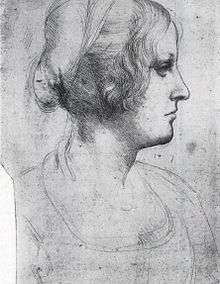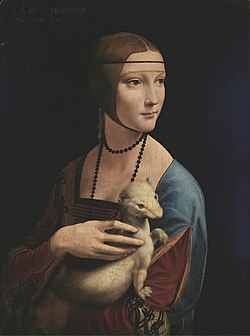Cecilia Gallerani
Cecilia Gallerani (Italian pronunciation: [tʃeˈtʃiːlja ɡalleˈraːni]; 1473–1536), born in Siena, Italy, was the favourite and most celebrated of the many mistresses of Ludovico Sforza, known as Lodovico il Moro, Duke of Milan. She is best known as the subject of Leonardo da Vinci's painting The Lady with an Ermine (circa 1489). While posing for the painting, she invited Leonardo, who at the time was working as court artist for Sforza, to meetings at which Milanese intellectuals discussed philosophy and other subjects. Cecilia herself presided over these discussions.

Cecilia Gallerani | |
|---|---|
 Cecilia Gallerani as The Lady with an Ermine, painted by Leonardo da Vinci around 1489 and displayed at the Czartoryski Museum in Kraków | |
| Born | 1473 |
| Died | 1536 Castle of San Giovanni in Croce, near Cremona, Italy |
| Nationality | Italian |
| Known for | being the subject of Leonardo da Vinci's painting The Lady with an Ermine being the mistress of Ludovico Sforza, Duke of Milan |
| Spouse(s) | Ludovico Carminati de' Brambilla, Count Bergamino |
| Children | (by Ludovico Sforza): Cesare Sforza Visconti (by Ludovico Carminati de' Brambilla): 4 children |
| Parent(s) | Fazio Gallerani Margherita Busti |
Family and early life
Cecilia was born into a large family from Siena. Her father's name was Fazio. He was not of nobility, but he occupied several posts at the Milanese court, including the position of ambassador to Florence and Lucca. Her mother was Margherita Busti, the daughter of a noted doctor of law.
She was educated alongside her six brothers in Latin and literature. In 1483 at the age of ten, Cecilia was betrothed to Stefano Visconti, but the betrothal was broken off in 1487 for unknown reasons. In May 1489, she left home for the Monastero Nuovo, and it was possibly there where she met Ludovico.
Mistress of Ludovico Sforza
Cecilia spoke Latin fluently and was said to be a gifted musician and singer. She also wrote poetry. In about 1489, she sat for Ludovico's court artist and engineer, Leonardo da Vinci, who painted her celebrated portrait, which is known as The Lady with an Ermine. Isabella d'Este, an admirer of the work of Leonardo da Vinci, asked to borrow the portrait, but Cecilia replied it no longer looked like her because she had been so young then and "nobody seeing it and me together would suppose it was made for me".[1] "Though reluctant because it no longer resembled her,[2] Cecilia complied, and by the following month the picture was gratefully returned".[3]
Even after Ludovico married Beatrice d'Este, Cecilia continued to keep her apartments in Ludovico's castle. She had a son, Cesare, on 3 May 1491 by Ludovico Sforza.
When Beatrice d'Este found out about their relationship, Ludovico was constrained to ask Cecilia to leave the Porta Giovia castle, the seat of the ducal court. She was first installed in the Verme Palace, and then given the Carmagnola Palace in 1492, when she married Count Ludovico Carminati de' Brambilla, known as "Il Bergamino". She bore her husband four children. After the death of both her husband and her son (1514–1515), she retired to San Giovanni in Croce, a castle near Cremona.
Cesare, the son of Cecilia and Ludovico Sforza was made abbot of the Church of San Nazaro Maggiore of Milan in 1498; in 1505, he became canon of Milan. He died in 1512.
Death and legacy
Cecilia died on an unknown date in 1536. She was allegedly buried in the Carminati family tomb in the Church of San Zavedro.
Bandello described her as a patron of the arts. According to others, hers was the first salon in Europe.
References
- Gilbert, C. E. (1980). p 142
- (Beltrami, no 89)
- (L’Arte (1969). pp. 189-91.)
Further reading
- Pizzigalli, Daniela (2003), La donna con l'ermellino, Rizzoli
- Shell, Janice & Sironi, Grazioso (1992), "Cecilia Gallerani: Leonardo's Lady with an Ermine", Artibus et Historiae, 13 (25): 47–66, doi:10.2307/1483456.
External links
- Leonardo da Vinci: anatomical drawings from the Royal Library, Windsor Castle, exhibition catalog fully online as PDF from The Metropolitan Museum of Art, which contains material on Cecilia Gallerani (see index)